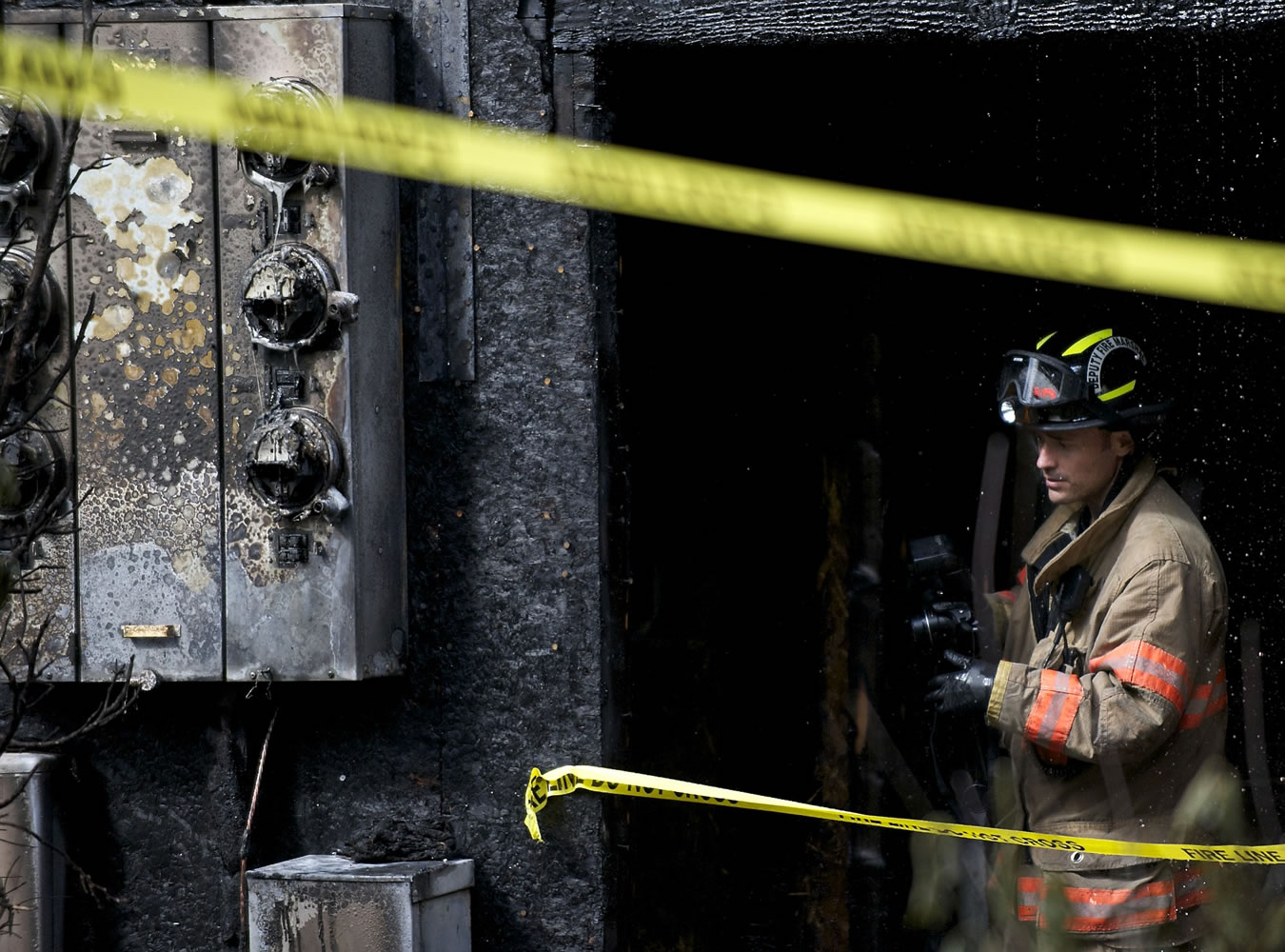Officials offer these fire safety tips for would-be tenants:
o Ask if the complex has a no-smoking policy. Improperly discarded smoking materials is a leading cause of residential fires.
o Find out if the building has fire sprinklers and where the sprinklers are. Apartment buildings with sprinklers offer a high level of fire safety.
o Find out if there are any pending inspection violations against the building manager. These questions can be posed to your local fire marshal’s office or your city’s building office.
o Buy renter’s insurance. According to the Northwest Insurance Council, the average premium for renters insurance in Washington is $14.50 a month.
o Look for primary and secondary evacuation routes from the apartment. Have a conversation with management about fire safety plans.
Interactive map
For an interactive map of Clark County apartment fires in recent years, click here:
http://tabsoft.co/1xdFKZ7
Apartment fires are on the rise in Clark County, causing more deaths and twice the amount of property damage this year than usual.
Fifty seven fires were reported in occupied apartment buildings in Clark County through October of this year, according to The Columbian’s analysis of data from local fire agencies. That’s already more apartment fires than the average rate of about 50 a year.
Of the four fatal fires in the county this year, two of those deaths occurred in an apartment complex. Those were the first apartment fire deaths in the county since 2011.
By the end of October of this year, the damage to apartment buildings and residents’ property totaled nearly $4.4 million, according to the data. That’s more than double the average value of property destroyed yearly by apartment fires from 2009 to 2013, which was about $2 million a year.
As the number of renters in the county increases and new apartment complexes are built to higher safety standards, officials remain focused on fire prevention for renters. Local fire marshals and landlords say they are intensifying their efforts to curb risky tenant behaviors that can cause these kinds of fires.
“The trends that we’re seeing are accidental fires caused by human behavior,” Vancouver Fire Marshal Heidi Scarpelli said. “Families in apartment buildings live close together and affect each other’s risk when it comes to fire.”
Hazel Dell blaze
Dozens of Clark County residents lost their homes and belongings in apartment blazes in 2014.
The largest fire of the year was at the Bridge Creek Apartment Homes on March 16. The early-morning blaze tore through 18 units at the Hazel Dell complex, 9211 N.E. 15th St., sending firefighters into an all-hands-on-deck response.
Tiffany Alziebler was one of the roughly 70 people who lost her home that night.
Her boyfriend woke her up to the ruckus, and Alziebler threw on some clothes, grabbed her cat, Dude, her purse and a coat, and ran outside.
Within minutes, Alziebler said, “it was pretty clear that I lost just about everything I owned.”
Deputy Clark County Fire Marshal Curtis Eavenson said smoldering smoking materials started the fire. No one was cited.
“We couldn’t pin down who was doing the smoking,” Eavenson said. “It was smoldering for some time before it came to life.”
Alziebler said that she is a smoker, but she’s meticulous about extinguishing her cigarettes in water.
“It sucks that somebody else’s mistake caused so many people to lose their homes and the stuff that they’ve been working hard for,” Alziebler said.
Along with cooking and candles, smoking is a leading cause of residential fires. Some smokers extinguish their cigarettes in potted plants, which Scarpelli said contain chemicals that let the embers smolder. Similarly, inattention plays a role in fires caused by candles and cooking.
Officials offer these fire safety tips for would-be tenants:
o Ask if the complex has a no-smoking policy. Improperly discarded smoking materials is a leading cause of residential fires.
o Find out if the building has fire sprinklers and where the sprinklers are. Apartment buildings with sprinklers offer a high level of fire safety.
o Find out if there are any pending inspection violations against the building manager. These questions can be posed to your local fire marshal's office or your city's building office.
o Buy renter's insurance. According to the Northwest Insurance Council, the average premium for renters insurance in Washington is $14.50 a month.
o Look for primary and secondary evacuation routes from the apartment. Have a conversation with management about fire safety plans.
“Cooking is an active process. You need to be at the stove,” Scarpelli said. A distraction such as a phone call can take your attention away and “pretty soon you have a full kitchen fire that puts the whole apartment complex at risk.”
The five most expensive apartment fires this year, each resulting in more than $100,000 in damage, were all unintentional. The sources for those fires included an electrical malfunction, hot embers or ash, and smoking materials. Of the two fatal apartment fires this year, both accidental, one was caused by smoking materials and the other was either caused by cigarettes or an electrical problem.
Renting on the rise
At a slow but steady pace, more Clark County residents are choosing to live in rentals, according to an analysis of more than 10 years worth of U.S. Census data. In 2000, 32.7 percent of Clark County residents rented, while 67.3 percent owned homes. By 2013, 35.7 percent rented and 64.3 percent owned homes.
From 2008 to 2012, an estimated 22.6 percent of Clark County households lived in multi-unit buildings, according to the Census. In Vancouver alone, an estimated 38.9 percent of households were in multi-unit buildings during the same time period.
And more apartments are on the horizon. In 2013, 92 new building permits were filed in the county for residential complexes with five or more units, according to Census data. That’s more permits than the previous five years combined.
Meanwhile, a majority of renters aren’t prepared to handle the fallout from a fire.
Just 31 percent of tenants purchase renter’s insurance, according to national Census numbers.
Alziebler, 28, had renter’s insurance, which helped her replace her belongings once she moved to another apartment complex.
“I always have it just because if anything happened, I didn’t have any savings,” she said. “My mom told me to always have insurance because you never know what’s going to happen.”
Building codes
Although older apartment complexes are often more affordable, they were built in compliance with fewer safety standards. Fire codes do not apply retroactively; if a safety code is put in place after an apartment complex is built, the property owner is not necessarily required to upgrade the building to meet those new standards.
Since the beginning of 2009, at least 161 fires have sparked in Clark County apartment buildings constructed before 1991, according to the data from local fire departments. Starting in 1991, builders were required to put smoke detectors in each bedroom, and install automatic sprinklers and automatic fire alarms in buildings that are either taller than three stories or have at least 16 units.
Those 161 fires caused more than $11.1 million in damage to apartment buildings and their contents, the data show.
During the same time period, however, 140 apartment fires in Clark County apartment buildings constructed after 1990 caused only about $3.2 million in damage.
By 2003, automatic fire sprinklers were required in newly constructed apartment buildings of any size. And even more safety features have been added over the years.
Complexes built today are required to have sprinklers in the stairwells, in the attic and on porches. Fire-resistant rock wool is used between floors, and fire putty is required around outlet boxes.
Fire officials said sprinklers would have greatly diminished the damage to this year’s fire at Bridge Creek Apartment Homes in Hazel Dell, which started in a third-floor hallway. Built in 1989, the structure’s lack of sprinklers “allowed the fire to grow to an extent that it got into the attic and then grew,” Clark County Fire Marshal Jon Dunaway said.
But while fire officials can advocate for more safety codes to help mitigate the flames, that ultimately won’t stop the root problem.
“More often than not, the fire is caused by the people rather than the building and the building system,” Dunaway said.
Changing behaviors
After fire investigators determine the cause of these apartment fires, they take the time to educate residents about fire safety — simple steps they can take to prevent the loss of property, a home or a loved one.
Local fire marshals offices regularly meet with landlords and send out a monthly newsletter to property managers of apartment complexes in an effort to keep those safety messages at the forefront.
The Vancouver Fire Marshal’s Office also is preparing to launch Project Home Safe, where volunteers will go door-to-door to spread safety messages. The project targets a densely populated area around Fourth Plain Boulevard that is home to several apartment complexes and has the highest fire-per-square-mile rate in Vancouver, based on eight years of data.
Lyn Ayers, president of the Clark County Rental Association, said he’s excited to see Project Home Safe get up and running but he’s skeptical that it will work.
“They’re trying to change behavior to more responsibility and that’s a tough challenge,” said Ayers, who has managed rental homes since the early 1980s.
Many landlords in the rental association have adopted no-smoking policies and some have even banned candles from rental units. But while adding fire safety components to a rental agreement may be well-meaning, Ayers said, it rarely results in change.
“The problem is your tenants typically read through the agreement, sign it, and then they put it away and forget about it,” he said. “It doesn’t really mean any behavior change. … It’s too easy to do it the way you’ve always done it.”
Web editor John Hill contributed to the data research and analysis.




